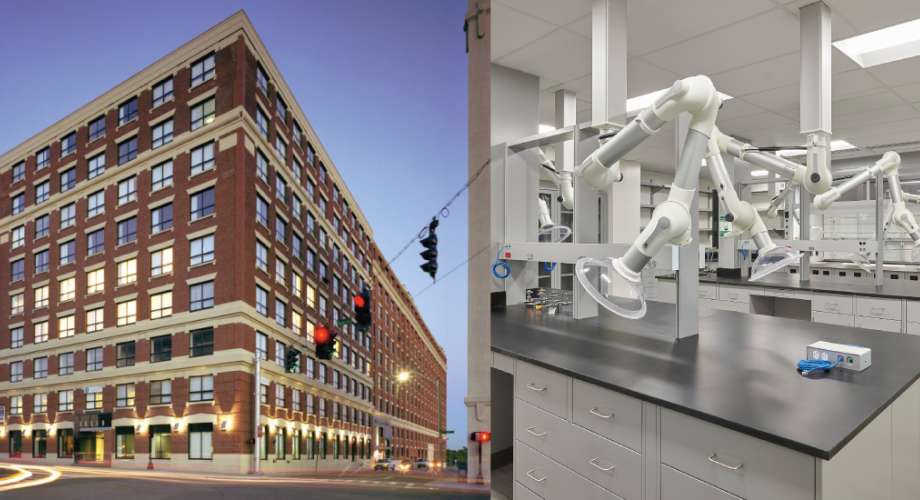Many developers are considering converting underutilized commercial office space into laboratories, especially since the Life Science industry has proven capable of withstanding the COVID-19 pandemic. The industry has been booming for some time now, and COVID-19 has prompted it to flourish in unprecedented ways. Large universities and healthcare institutions have a heightened demand for Life Science facilities to be located on or near their campuses, and developers are eager to deliver. Between record-breaking biotech funding from pharmaceutical firms and venture capital and the prevalent “work-from-home” mindset, many developers are using this industry boom to create sought-after lab spaces from vacant commercial offices.
According to Pitchbook, private venture capital biotech funds raised an incredible $6.4B in the second quarter of 2020. Combined with an annual $155B research budget from pharmaceutical firms and billions from the National Institute of Health, it is no wonder the July 6, 2020 issue of the Commercial Observer claims “Life Science Is Pandemic-Proof Real Estate.”
Bala is actively working with several developers to investigate converting all or portions of office buildings to laboratory space. Prior to the pandemic, our Boston office was involved in multiple office to lab conversion projects in Cambridge and this interest has leap-frogged over to the Seaport and the Greater Boston area. We are currently evaluating the repositioning of over 1 million square feet of existing office space into laboratory space across many regions.
The conversion of an existing building into a lab requires highly technical analysis as well as an understanding of both high-rise and laboratory systems. Facility infrastructure needs for laboratories are beyond the standard design capacities of typical commercial buildings. Some engineering-related items that need to be closely considered include: lab exhaust, ventilation/make-up air, conditioning, normal power, standby power, domestic water, lab waste, sanitary waste and fire protection.
_NewarkDe%20IMC_Nov2019_RVOIIIPhoto_13658.jpg)
LAB EXHAUST – The lab exhaust system presents some of the biggest challenges when repositioning an existing office building into lab space. In high-rise buildings, finding continuous shaft space to the roof area can be a challenge and may require innovative thinking. Low-rise buildings are generally more easily transitioned because of their flexibility between floors and relative ease of access to the roof. The urban setting for lab space also presents its own set of challenges including tight lot lines, less flexibility on facades and re-entrainment of air to the building or neighboring buildings. When programming spaces, consider the need for flexibility versus minimizing hazardous exhaust (fume hood, point exhaust, etc.) to reduce the required exhaust and makeup air.
VENTILATION / MAKEUP AIR – The difficulties of providing sufficient makeup air, equal to the exhaust quantity, mimics the challenges noted above. However, providing makeup air is slightly more flexible if floor by floor makeup air in lieu of central is possible. Lab spaces typically require a minimum of 5x the quantity of outdoor air as typical office spaces, making this a global change to the approach of supplying air to the space.
CONDITIONING – With the increase in ventilation air that will need to be conditioned and an increase in power used within the space, the repositioning of a commercial product may require supplementing the central systems. The required conditioning on each lab floor is at least 2x that of a typical commercial office building. As with many aspects of lab spaces, low-rise buildings offer more flexibility, but custom-fit solutions can be applied to high-rise buildings.
NORMAL POWER – The power needs for a laboratory building are well above those of an office building—at least 2x as much. Depending on the amount of space being converted to lab, it could be as easy as providing a new feeder from an existing substation or as difficult as providing another service from the utility and adding electrical gear within the building. It is rare that an existing building can be repositioned to a laboratory building without some level of power upgrades.
STANDBY POWER – In addition to the increase of normal power, available standby power is required for laboratory buildings. Standby power is needed for exhaust, life safety, and temperature control. In many cases, sufficient standby power does not already exist within the building, so alternate solutions for locating generator(s) may be required. The amount of combustion and exhaust air needed for generators may require “thinking outside of the box” to size and position the generator while minimizing re-entrainment issues. As noted with ventilation, it is important to weigh the importance of flexibility versus minimizing need for standby power. Depending upon tenant needs, it is possible to minimize exhaust ventilation to achieve minimal safe airflow at fume hoods. The use of controlled environmental chambers in lieu of relying on space conditioning will also minimize the amount of standby power required for ventilation systems.

DOMESTIC WATER – The demand for hot and cold water in lab spaces is well above what is needed for commercial office buildings. Due to the increased need, the entire domestic water system should be evaluated, from the incoming service to the distribution piping. Without sufficient and properly tempered water, lab spaces cannot operate. To provide sufficient water supply to lab functions, it may be necessary for tenants to employ storage based systems that require a lower amount of continuous make up water and rely on stored volume to provide the typical infrequent demand of lab based systems. Additionally, the building owner may also want to install dedicated lab cold water risers, which will require chase space and penetrations within the building.
LAB WASTE – Each tenant may require some form of laboratory waste. These systems typically require neutralization before discharging to sanitary waste systems. For highly corrosive and flammable waste, specialized containment systems may be required to hold waste before it is safely disposed. The responsibility of these systems normally falls to the tenants. Careful consideration for the spaces beneath lab tenants is needed, due to the routing of laboratory waste piping serving their spaces. Another alternative is for tenants to utilize small containment or neutralization systems beneath each drain point.
SANITARY WASTE – The increase in flow from lab waste alone will require a full analysis of the sanitary system of an existing commercial office building. It is possible that in some locations along the path for the sanitary runs, the existing system will need to be upsized to accept lab waste. Since lab waste systems utilize neutralization equipment to hold and treat waste before discharging it to sanitary waste systems, it is possible to minimize peak flows allowing the existing main piping to accommodate them. In many cases, the building owner may also want to install dedicated lab waste risers, which will require chase space and penetrations within the building. These may tie into the sanitary waste system if the tenants neutralize their own lab waste, otherwise they may tie into central lab waste neutralization systems before they are discharged into sanitary waste. Careful consideration for the spaces below lab tenants is also needed for the increased routing of sanitary waste piping and locating neutralization components.
FIRE PROTECTION – Lab spaces are required to comply with head spacing as depicted by NFPA 13 Ordinary Hazard. Many commercial buildings are designed around Light Hazard occupancies for most of the building. While head spacing can be modified in small scales without concern, changing large amounts of spaces from Light Hazard to Ordinary Hazard may require an analysis of sprinkler mains on each floor, and possibly a review of the building’s standpipes.
As we have learned, change is constant and the ability to adapt is critical. Increased demand for lab spaces presents an opportunity for all building owners to respond and provide productive and effective spaces to fill these needs. With careful evaluation and planning between building owners, tenants and design and construction professionals the possibilities are endless.


